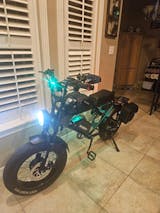Table of Contents
- What Is an Ebike Speed Limiter?
- Why Do Ebikes Have Speed Limiters?
- How Riders Remove Ebike Speed Limiters (For Informational Purposes Only)
- Pros and Cons of Removing an Ebike Speed Limiter
- Legal and Safety Considerations
- Other Ways to Increase Ebike Performance (Instead of Disabling Limiters)
- Conclusion
- FAQs
Ebike speed limitations are built -in controls that limit the maximum speed of the electric bike. Manufacturers include them to comply with Ebike speed regulations, security and legal use on public roads. These limitations limit the speed of the bike, usually around 20-28 mph, depending on the model and local laws.
Some riders are looking for ways to circumvent the speed limiter to release more energy, believe it can unlock faster speeds and provide exciting ride. But is it really necessary?
Does disabling an ebike speed limiter bring any benefits, or does it create more risks? Understanding its effects on battery life, motor performance and legal standing before making your decision is vitally important.
What Is an Ebike Speed Limiter?
Ebike speed is an electronic control that regulates how quickly the electric bike can go. This is because you control the power supply to the engine and keeps the statutory speed limits (usually 20 mph in class 1 and 2 or 28 mph for class 3) depending on the local regulations for this region.
This limiter utilizes an ebike motor controller and speed sensor to track velocity of the bicycle. When reaching its preset speed, power output automatically decreases preventing further acceleration; pedal assist system and throttle are also affected, making it impossible to exceed manufacturer's limits without modifications.
Manufacturers include restrictions in their products to meet safety standards and safeguard the battery management system from excessive strain, providing longer-lasting performance while at the same time protecting it from undue stress. While this makes for smoother riding experience on private property or off-road terrain, riders may find them restrictive. As a result, many search for ways to modify ebike speeds to bypass or bypass this limiter altogether.
Why Do Ebikes Have Speed Limiters?
Ebike speed limiters exist for legal, safety, and performance considerations. Most countries impose stringent ebike regulations with speeds capped between 20-28 mph to classify them as bicycles rather than motor vehicles. Removing an ebike's speed limiter could render your bike an unregulated motorized vehicle and thus illegal to ride on public roads; depending on local laws this could result in fines, penalties, or even vehicle confiscation.
Beyond legal concerns, speed modifications on an ebike also present safety issues for riders. Ebikes are designed to operate within specified speeds in order to preserve braking efficiency and stability; by disabling this limiter and increasing accident risks through higher speeds. Faster speeds also demand faster reaction times which increases chances of losing control.
One more factor is battery and motor efficiency and lifespan. High speeds drain batteries faster, decreasing overall range. Furthermore, any motor controller modification required to bypass speed limiters may strain and strain motors prematurely leading to overheating and early wear on them - further underscoring their importance in long-term performance. Therefore, speed limiters on ebikes must be strictly enforced.
How Riders Remove Ebike Speed Limiters (For Informational Purposes Only)
Some riders attempt to bypass their ebike's speed limiter to increase its performance. One method involves altering its firmware update in order to override factory settings by accessing motor controller modification software and altering speed restrictions; alternatively, another approach could involve manipulating its speed sensor by moving or disconnecting it - these tricks may allow higher speeds through.
Modifying an ebike speed limiter yourself may appear straightforward, but doing it yourself poses many risks. Interfering with its battery management system could result in overheating, short circuiting or reduced battery life; also it voids manufacturer warranties which means any damages sustained to motor controller or components won't be covered; in addition, certain firmware changes cannot be undone and factory settings can no longer be restored to their previous state.
Tools such as programming cables, diagnostic software, and speed sensor adjusters may be required for those seeking to modify the speed of an ebike, however tampering with any of these components could lead to legal ramifications, unsafe riding conditions, and costly repairs.
Pros and Cons of Removing an Ebike Speed Limiter
Eliminating an ebike speed limiter entails both benefits and risks, with riders generally preferring the added power. Other riders might find that the drawbacks outweigh these advantages; here is an in-depth examination of both sides before making your decision.
1. Pros of Removing an Ebike Speed Limiter
- Increased Power and Speed: Without its limits in place, an ebike can achieve higher speeds more suitable for off-road and private property riding, providing riders with more thrill and performance potential an enormous benefit.
- Private Property Offers Fewer Restrictions: Riding on private land may allow for higher-speed testing and personal enjoyment without legal considerations being an issue.
- Improved Performance on Open Terrain: Faster speeds can help enhance performance in rural environments, steep inclines, or long distance travel, where being limited by speed restrictions could otherwise feel restrictive.
2. Cons of Removing an Ebike Speed Limiter
- Legal Penalties and Compliance Issues: Many countries classify ebikes according to their speed. Removing an ebike speed limiter doing so could reclassify it as a motorized vehicle requiring license, insurance, registration etc if caught modifying it further - fines or confiscation being one possibility as well.
- Ebike Safety Considerations: At higher speeds, more effective brakes, stronger frames and quicker reaction times become essential to ensure safe riding experiences. Unfortunately, most stock ebikes were not designed with these characteristics in mind and increase the risk of accidents or injuries as a result.
- Battery Management System Efficiency Declines: Increased speed is associated with greater power consumption, so removing the limiter drains the battery faster, shortening range, and potentially overheating motor controllers; leading to premature motor failure and costly repairs.
While eliminating a limiter may seem appealing, it is essential to carefully evaluate both its advantages and risks when considering safety, legal restrictions, and long-term performance.
Legal and Safety Considerations
Laws regarding de-restriction of electric bikes vary by country, state and city. Electric bikes are usually classified based on maximum speed and motor power - bypassing their speed limiters can result in their bike becoming no longer deemed an ebike and instead classified as a motor vehicle requiring registration, insurance and a valid license to operate publicly - leading to fines, penalties or even confiscation if caught riding an illegally modified ebike.
Absenteeism of speed limit bypass can present serious safety risks. Brakes, tires and frames were designed for specific speeds; when these speeds are exceeded, instability occurs and braking distance increases dramatically; this increases the risks of losing control, colliding into pedestrians or other vehicles or even overheating motor controllers and battery management systems with possible mechanical failure or sudden power losses - these risks make ebike speed modification a risky endeavor that should only be used occasionally by commuters who depend on them for daily commuting purposes.
Other Ways to Increase Ebike Performance (Instead of Disabling Limiters)
Removing the speed limiter of an electric bike may pose legal and safety hazards; there are safer ways to enhance performance instead. One such upgrade is switching to a higher voltage battery; more powerful batteries provide stronger acceleration, torque increases, and longer range without jeopardizing its safety features. Just ensure it fits with your motor controller to prevent overheating or damage.
Modifying an ebike motor controller can also be an effective strategy. An ebike's motor controller regulates power from its battery to the motor. Upgrading to a higher-efficiency controller can improve power delivery while still meeting safe speed limits; some controllers also allow custom tuning to optimize energy efficiency and smooth acceleration.
Adjusting ebike throttle tuning can increase power output. Many ebikes provide adjustable settings that enable fine-tuning acceleration response and changing throttle sensitivity to give an impression of greater power without exceeding legal speed limits, keeping your ride safe and compliant.
Conclusion
Removing an ebike speed limiter may increase speed and performance, but doing so comes with legal risks, safety issues, and possibly damage to both motor and battery. While some riders may benefit from additional power on private property or off-road trails, doing it on public roads could result in fines, accidents and warranty issues that affect riders' driving privileges.
People who rely on an ebike for daily commuter needs should refrain from altering the speed, as doing so may reduce battery life and compromise reliability. On the other hand, experienced riders in controlled environments may find removing a limiter beneficial.
Ultimately, bypassing a limiter may outweigh its benefits; upgrading battery, motor controller or throttle tuning are safer ways of improving performance without legal or safety considerations.
FAQs
1. Is It Illegal to Remove an Ebike Speed Limiter?
This depends on where you live. Some regions classify modified ebikes as motor vehicles requiring registration, insurance and license requirements if used on public roads; while de-restricted use on private property is typically allowed. Always consult local laws before altering your bike.
2. Will disabling my speed limiter damage my ebike?
Unfortunately, yes. Removing the limiter places additional strain on the motor, battery and controller and may lead to overheating, faster battery drain and potential system failures. Furthermore, its battery management system may not be capable of handling the extra load and may shorten lifespan significantly; plus it could invalidate warranties leaving you responsible for costly repairs.
3. How can I speed up my ebike without disabling its limiters?
To increase speed and performance without bypassing legal speed limits, upgrades such as upgrading to a higher voltage battery or installing a more efficient motor controller or tweaking throttle tuning may provide significant power increases without exceeding legal speed limits, improving acceleration while keeping it road legal - while at the same time improving acceleration quality and ride quality.




















